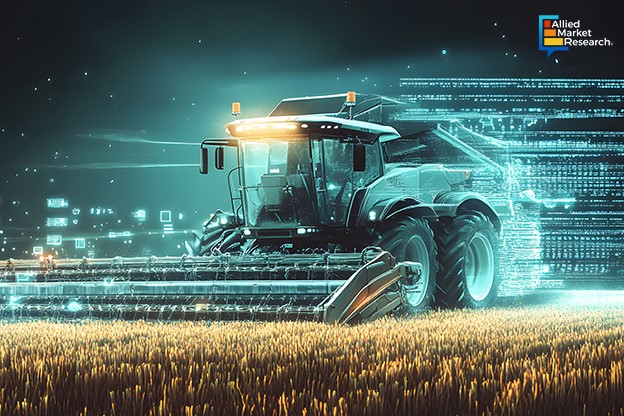Smart Agriculture: An Innovative Approach to Increase Farm Productivity in Drought-Prone Areas

27 Dec
2024
Key takeaways:
- Introduction
- Role of smart farming in improving crop yield
- Integration of AI and automation techniques
Out of all the main sectors of the global economy, agriculture and livestock rearing is one of the most labor-intensive and unproductive occupations. The aversion to technology adoption remains an important challenge in the agriculture sector in countries such as India, China, Brazil, etc. Land fragmentation is one of the main reasons behind the slow-paced penetration of advanced technologies in farming activities. For example, in India, more than 85% of the farmers are small and marginal, i.e., they own less than 2 hectares of land. Naturally, the income of such cultivators is quite low, which discourages them from investing in farm innovations.
However, in the last few years, the idea of farmer cooperatives and producer companies has helped small farmers come together, pool their resources, and improve their spending capabilities. At the same time, many countries have placed huge emphasis on improving the productivity of their agriculture sectors by providing digital technologies at subsidized rates. The smart agriculture industry has witnessed significant growth due to these initiatives, thus expanding the scope of the landscape in developing countries.
Increasing preference for smart agriculture in drought-prone countries
Smart agriculture involves the use of advanced digital technologies and data-driven processes to enhance farm productivity and crop yield. In the last few decades, the demand for these modern farming techniques has increased immensely due to the rising pace of climate change. Environmental studies have shown that global warming is detrimental to crop growth and reduces the harvest significantly, especially in tropical regions. The surge in extreme weather events, such as droughts, has significantly heightened the risk of crop failures. In drought-prone areas, heat waves further aggravate the problem of water scarcity, thus ultimately bringing down crop productivity. In such a scenario, smart agriculture becomes an ideal solution to ensure food security. As per the International Monetary Fund, global agriculture production needs to increase by around 70% by 2050 to meet the current population growth rate, and data-driven farming techniques are essential to achieving this goal.
One important component of smart farming is precision agriculture which involves the use of advanced sensor technology and data analysis tools for targeted crop cultivation. Innovations in the field of geospatial mapping and GPS systems have played an important role in popularizing the idea of precision agriculture. Farmers across the globe have started using satellites and other earth observation equipment to gain insights into various parameters such as climatic conditions, soil conditions, crop health, and land use patterns.
The main aim behind using techniques is to aid cultivators in accurate, real-time harvest monitoring. Furthermore, geospatial imaging technologies also help detect pests, weeds, and disease outbreaks at early stages, thus lowering the possibility of crop damage. Agriculturists recommend the use of multispectral imaging techniques to optimize the use of pesticides, fertilizers, and water, thus minimizing resource wastage in drought-prone areas. Moreover, the advent of synthetic aperture radars and LiDAR technology has enabled farmers to study the terrain, weather conditions, and vegetation structure and decide the cropping patterns accordingly.
Automation and AI transforming the smart agriculture industry
The gradual transition toward Industry 4.0 and the launch of 5G services in developed and developing countries has broadened the scope of automation technologies considerably. Over the years, agriculture companies have started deploying automation and robotics to improve crop yields and increase farm productivity. The main motive behind the use of these techniques is to perform repetitive tasks such as sowing, spraying, weeding, etc., thereby freeing up labor for more productive tasks.
Along with governmental initiatives, private companies, too, have invested hugely in smart agriculture solutions to meet the demands of their customer base and expand their footprint across the globe. In September 2023, Robotics Plus, an industrial automation firm in New Zealand, announced the launch of an autonomous vehicle, Prospr. Developed to perform several vineyard and orchard crop tasks, the robotic system features multiple swappable tools and sensing devices to carry out cutting and spraying activities seamlessly.
Apart from automation, artificial intelligence has also been an important contributor to the growth of the smart agriculture industry. AI-based tools are now widely being used for early disease detection and diagnosis. As per a research paper published in the Computers and Electronics in Agriculture journal, the deployment of neural networks in farming activities has shown a 95% accuracy in the identification of crop diseases. Along with this, machine learning algorithms are also being used to power automated weed control systems that assist in precision herbicide application. Ultimately, this has not only limited the excessive application of chemicals but also reduced the environmental pollution caused by these compounds.
In conclusion, the demand for smart agriculture techniques has been growing in the last few years to enhance farm productivity and increase crop yields. Additionally, the gradual adoption of geospatial imaging technologies has impacted the industry positively. Moreover, the emergence of AI and automation is expected to revolutionize the landscape in the coming period.
Contact our experts for the upcoming trends and latest advancements in the smart agriculture industry!

Akhilesh Prabhugaonkar
Author's Bio- Akhilesh Prabhugaonkar holds a bachelor’s degree in Electronics Engineering from the reputed Vishwakarma Institute of Technology. He has a special interest in the fields of forensics, world history, international relations and foreign policy, sports, agriculture, astronomy, security, and oceanography. An ardent bibliophile and melophile, Akhilesh loves to write on topics of his interest and various other societal issues. This love for writing made him enter the professional world of content writing and pursue his career in this direction.
Avenue: Entire Library membership of Allied Market Research Reports at your disposal
- Avenue is an innovative subscription-based online report database.
- Avail an online access to the entire library of syndicated reports on more than 2,000 niche industries and company profiles on more than 12,000 firms across 11 domains.
- A cost-effective model tailored for entrepreneurs, investors, and students & researchers at universities.
- Request customizations, suggest new reports, and avail analyst support as per your requirements.
- Get an access to the library of reports at any time from any device and anywhere.
Related Post
-
How are Submarine Cables Transforming Global Connectivity with Enhanced User Experience?
-
Endoscopy Procedures: Transformations in Techniques and Applications
-
AI-Powered Video Analytics: How the Product Actually Works for enterprises
-
Painting Robots: Transforming Precision Coating and Creative Applications
-
Innovations in Pharmacovigilance Systems Advancing Patient Safety
-
Understanding Edge Security: Keeping Data Safe Near the Source
-
Exploring the Use and Advancements of 3D Laser Scanners in Professional Applications
-
Reinforcing Industrial Controls with Smarter Tools and Training








